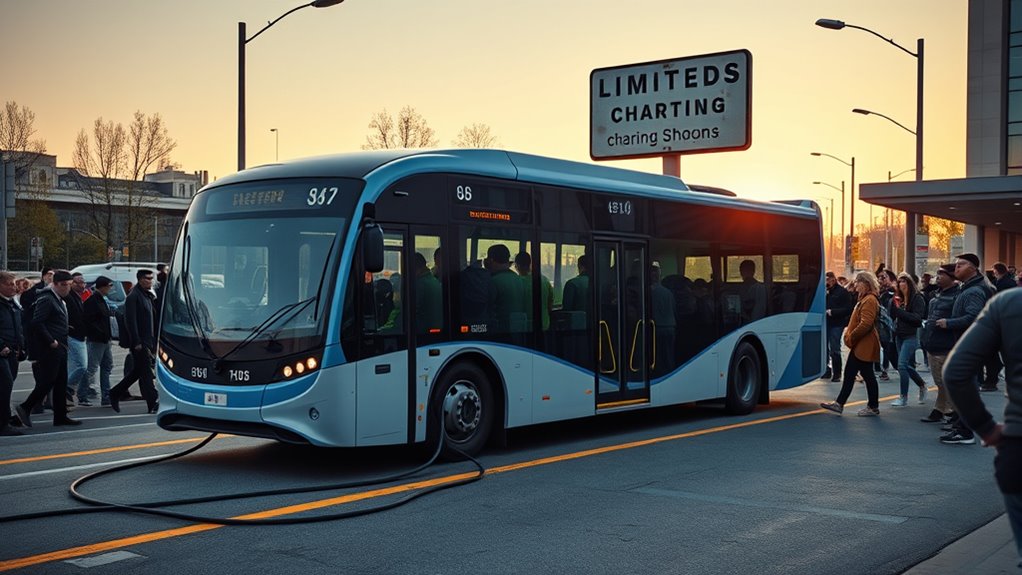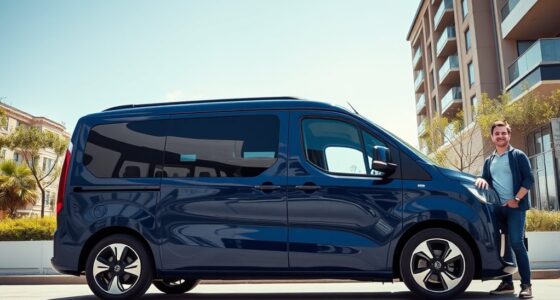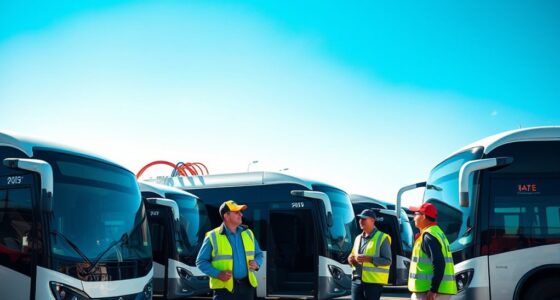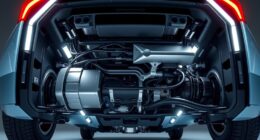As an early adopter of electric buses, you’ll face high upfront costs and the need for charging infrastructure, which can strain budgets and complicate planning. Limited charging stations and grid capacity issues may disrupt routes, while battery technology still has performance and cost hurdles. Bureaucratic hurdles and uncertain policies can slow progress, and managing energy use and infrastructure growth adds complexity. If you want to overcome these challenges effectively, explore the strategies that can help you succeed.
Key Takeaways
- High initial costs and infrastructure investments create financial barriers for early adopters.
- Limited charging stations and grid capacity issues hinder efficient route planning and operations.
- Battery technology still presents challenges in performance, durability, and cost management.
- Bureaucratic delays and lack of clear policies slow down adoption and implementation processes.
- Managing charging schedules and predicting future infrastructure needs complicate operational planning.
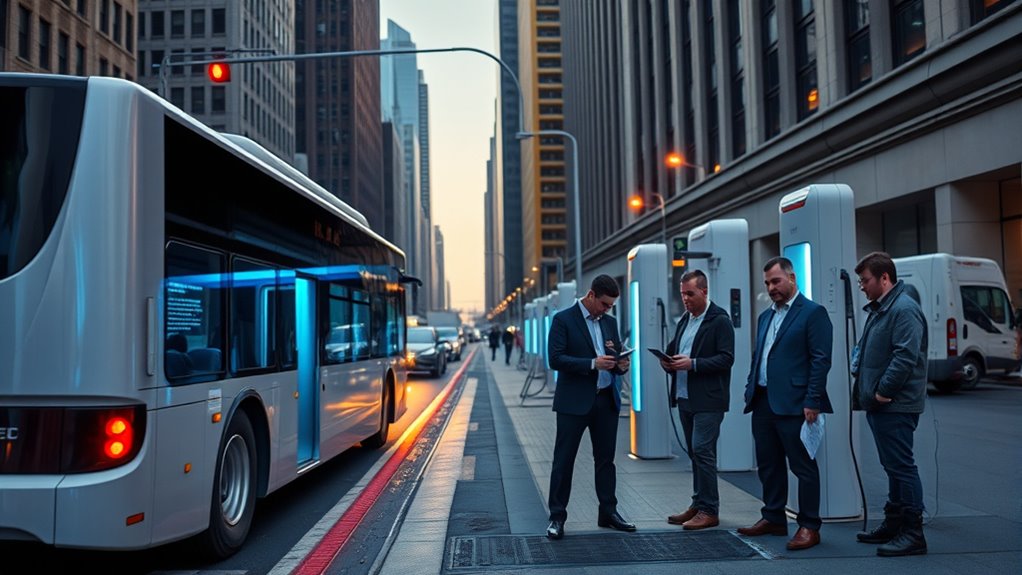
Adopting electric buses presents numerous challenges that early adopters must steer through. One of the biggest hurdles is the high upfront cost. Electric buses are more expensive than diesel models, and the expense extends beyond the vehicles themselves. You’ll need to invest heavily in charging infrastructure, which can be a significant financial burden. Procurement processes often favor cheaper, traditional options, making it difficult to justify the initial investment in e-buses without government incentives. While the long-term savings on fuel and maintenance are promising, convincing stakeholders to approve such a costly shift can be tough.
Infrastructure constraints also pose serious obstacles. Limited availability of charging stations makes planning routes and schedules more complex. You must carefully assess where to place charging points and how to expand them as your fleet grows, which requires strategic foresight. Grid capacity is another concern. Ensuring your local electrical grid can handle the increased load is a technical challenge, especially in areas where infrastructure is outdated or already strained. Charging infrastructure is a critical component that can determine the success of electric bus adoption.
Additionally, differences in charging standards can complicate fleet management, as incompatible chargers may require multiple types of equipment. Rural areas face even greater difficulties, often lacking the necessary infrastructure altogether, which limits the reach of electric buses outside urban centers.
Technological barriers further impede early adoption. Battery technology is improving but still faces issues related to efficiency, durability, and cost. You need to stay updated on advancements and choose batteries that strike the right balance between lifespan and performance. Managing energy use efficiently and scheduling charging times to optimize battery life adds layers of complexity.
Integrating electric buses into existing transportation systems requires compatible technology and system upgrades, which can be time-consuming and costly. Data analytics can help you optimize routes and charging schedules, but implementing these tools requires technical expertise and investment.
Institutional hurdles also slow down adoption. Risk aversion among fleet managers and bureaucratic processes can delay decision-making. Many cities or organizations lack the institutional capacity or governance structures needed to support a smooth shift.
Public support and awareness play crucial roles in driving political will, but educating the community about the benefits of electric buses takes effort. Developing a supportive regulatory framework is essential to remove legal barriers and encourage wider adoption, yet many regions lack clear policies or incentives.
Operational challenges demand careful planning. You must determine current and future charging needs, which involves predicting growth and adjusting infrastructure accordingly. Route optimization becomes more complicated when considering battery range and charging times, requiring you to adapt schedules constantly. Furthermore, understanding asset division principles can help organizations allocate resources effectively during transitions to new technologies.
Balancing these operational factors while maintaining service quality adds to the overall complexity of early electric bus adoption. Despite these obstacles, many early adopters recognize the long-term benefits, but steering through these challenges requires careful planning, investment, and patience.
Frequently Asked Questions
How Do Electric Buses Impact Overall Transportation Costs?
Electric buses substantially reduce your transportation costs by cutting fuel expenses to about 40% of diesel costs. They also lower maintenance needs thanks to fewer moving parts.
You’ll save thousands over their lifespan, and with vehicle-to-grid tech, you can generate extra income.
Although upfront costs are higher, long-term savings, improved efficiency, and potential revenue streams make electric buses a cost-effective choice for your transit system.
What Are the Long-Term Maintenance Considerations for Electric Buses?
You need to contemplate long-term maintenance for electric buses, including regular battery health monitoring, temperature control, and scheduled charging to prevent degradation.
Keep up with inverter and sensor inspections, high-voltage cable checks, and software updates.
Train your technicians on EV-specific diagnostics and safety protocols.
Also, plan for infrastructure needs like efficient charging stations and data collection to optimize performance and reduce future costs.
How Do Electric Buses Perform in Extreme Weather Conditions?
Imagine steering your electric bus through a snowstorm or heatwave—its weight distribution offers better traction and stability, helping you stay safe.
Designed for extreme weather, it adapts with advanced systems to protect its electrical components and optimize energy use. You’ll notice improved handling and control, even in severe conditions.
With proper maintenance and route planning, your bus remains reliable, no matter how harsh the weather gets.
What Training Is Needed for Operators of Electric Buses?
You need extensive training to operate electric buses effectively. This includes safety awareness, understanding electrical systems, and specialized driving techniques to maximize range.
You’ll also learn maintenance, troubleshooting, and how to use advanced safety features. Training should incorporate simulation tools and comply with industry standards, ensuring you’re prepared for real-world scenarios.
Continuous professional development and collaboration with industry experts are essential to stay current with evolving technology.
How Does Infrastructure Development Influence Electric Bus Adoption?
Think of infrastructure development as laying a strong foundation for electric bus adoption. When you invest in sufficient charging stations, upgrade grid capacity, and plan holistically, you create a smooth ride toward electrification.
Good infrastructure reduces operational hiccups, cuts costs, and encourages wider adoption. Without it, you’re just putting the cart before the horse.
Proper planning guarantees electric buses become a sustainable, efficient, and environmentally friendly transportation solution for your city.
Conclusion
As you navigate the path of early adoption, remember that these challenges aren’t insurmountable, but they do demand resilience and innovation. The hurdles you face today could open breakthroughs tomorrow, transforming public transportation forever. Stay vigilant, adapt quickly, and keep pushing forward—because what lies ahead might just redefine the future of green mobility in ways you haven’t yet imagined. The journey is tough, but the rewards could be beyond anything you’ve envisioned.
